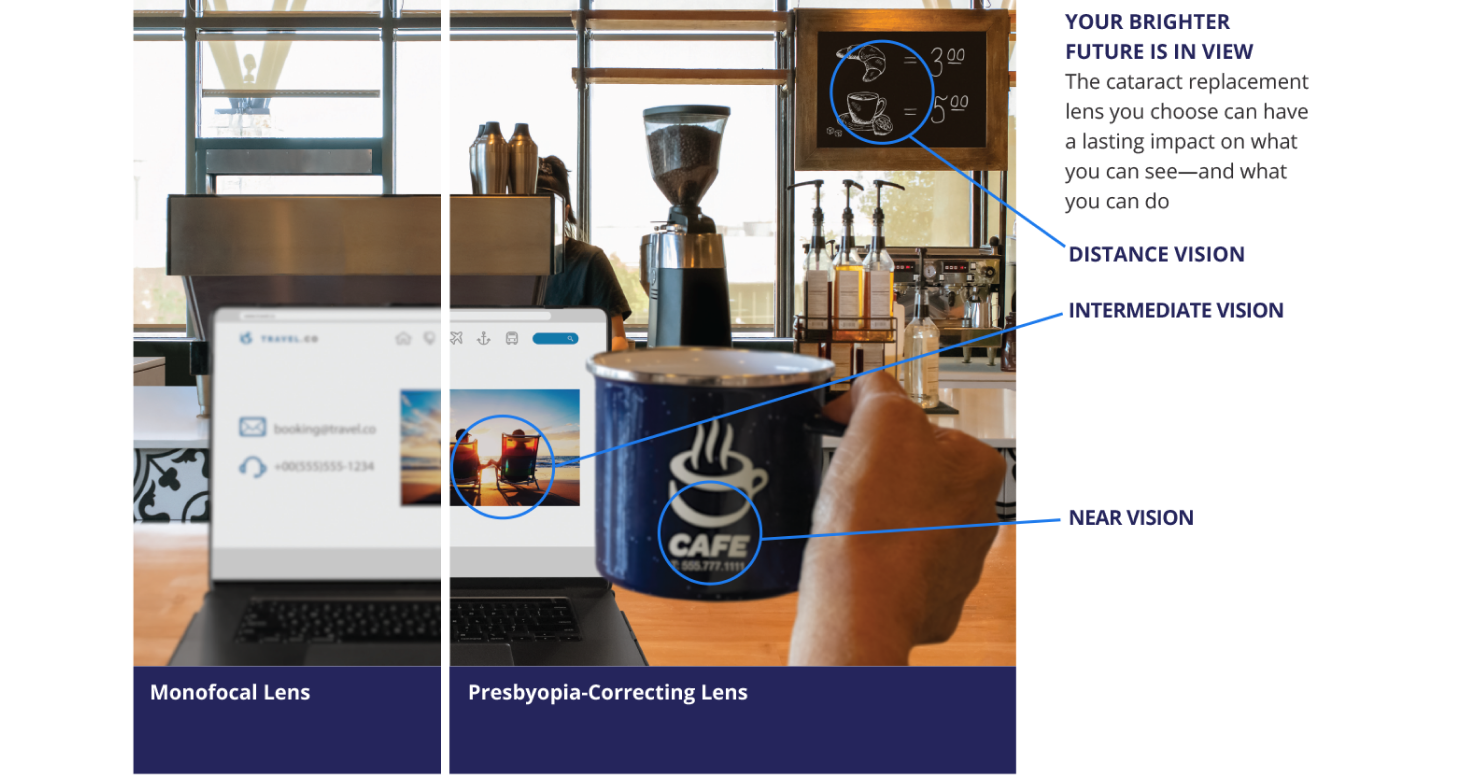|
|
SEE THINGS DIFFERENTLY
WITH EXCEPTIONAL CLARITY
Start Your Journey Toward a Future without Cataracts
Clareon® Monofocal is our standard cataract replacement intraocular lens. It provides exceptional clarity for distance vision.1,2 You may be able to see with clarity far away, but you will likely still need glasses to see up close and at arm’s length. If you have astigmatism, you will likely need glasses at all distances.
With a special monofocal lens, you can correct astigmatism, too.

Benefits of Clareon® Monofocal Lens
|
|
The most common type of implanted IOL and covered by most insurances |
Monofocal lenses are only one option. You have a choice when it comes to the right type of lens for you.
COMPARE CLAREON® INTRAOCULAR LENSES
Know Your Options.
Put Your Future in Focus.
Here’s a visual example to help you understand the kind of vision improvements that come with a
Clareon® Monofocal intraocular lens vs. a lens that corrects Presbyopia.

Frequently Asked Questions About
Monofocal Intraocular Lenses
Get the information you need to guide you to an informed decision about the cataract replacement lens that best fits your budget and your lifestyle.
CAN I ELIMINATE THE NEED FOR GLASSES OR CONTACT LENSES ALTOGETHER?
While monofocal intraocular lenses are designed to improve distance vision only, Multifocal and Extended Depth of Focus (EDOF) lenses are considered advanced lenses and can reduce the need for glasses or contact lenses altogether.3-5 If that’s what you have in mind you may want to explore the Clareon® PanOptix® Intraocular Lens or Clareon® Vivity® Intraocular Lens. You have options—compare the lens technology between all of our Clareon® intraocular lenses here. LINK TO
WHAT IS A MONOFOCAL INTRAOCULAR LENS
A monofocal intraocular lens is a lens that is surgically implanted in the eye to replace the natural lens that has become cloudy due to cataracts. This lens can provide clear distance vision,1,2 but it cannot adjust to focus on objects at varying distances. Therefore, glasses or contact lenses may still be required to correct near or intermediate vision.
IS THE CLAREON® MONOFOCAL INTRAOCULAR LENS RIGHT FOR ME?
You have options when it comes to cataract surgery. Choosing the right lens for your needs is a personal decision that should be discussed with your eye surgeon. Here are some general guidelines to help determine if a monofocal lens is right for you:
• You are primarily concerned with achieving clear distance vision
• You do not mind wearing glasses or contact lenses for near or intermediate vision
• You have no other significant eye conditions that may affect your vision
If this sounds like you, a Clareon® Monofocal intraocular lens may be an excellent choice. However, keep in mind that everyone's eyes are different, and a thorough consultation with an experienced eye surgeon is essential to determine the best course of treatment for your specific needs.
IS A MONOFOCAL INTRAOCULAR LENS COVERED BY INSURANCE?
Medicare and most insurance companies do cover the cost of the most common lens, the monofocal lens. These lenses have been used for decades and are the most common type.6
Multifocal, Extended Depth of Focus, toric and accommodative Iintraocular lenses are considered advanced technology lenses and can reduce the need for glasses or contact lenses.3-5 But the ability to read and perform other tasks without glasses varies from person to person. They are more expensive than monofocals and are usually paid out of pocket.6 Learn more about the cost of cataract surgery and insurance coverage.
Lead the Conversation
You have options when it comes to your intraocular lenses. Lead the conversation with your doctor to understand the cataract lens choice that’s right for you.
Find a cataract surgeon near you
Use our Cataract Surgeon Finder tool to locate a surgeon near you who offers a range of IOL options

IMPORTANT PRODUCT INFORMATION - CLAREON® FAMILY OF IOLS
CAUTION: Restricted by law to sale by or on the order of a physician.
DESCRIPTION: The Clareon® Family of Lenses are artificial lenses implanted in the eye of adult patients following cataract surgery. The Clareon® Aspheric Hydrophobic Acrylic IOLs are designed to allow for clear distance vision. However, you will likely still need glasses for reading and for distance vision particularly if you already have astigmatism. The Clareon® PanOptix® Trifocal Hydrophobic IOL is a type of multifocal lens (sometimes called “presbyopia-correcting IOL”) designed to allow for clear distance, intermediate, and near vision with the potential to be more independent of the need to use glasses for daily tasks. The Clareon® Vivity® Extended Vision Hydrophobic Posterior Chamber IOL provides clear distance vision, and better intermediate and some near vision compared to a monofocal IOL. The Clareon® Aspheric Toric, Clareon® PanOptix® Toric, and Clareon® Vivity® Toric IOLs are also designed to correct pre-existing corneal astigmatism, which is the inability of the eye to focus clearly at any distance because of difference curvatures on the cornea, and provide distance vision.
WARNINGS / PRECAUTIONS: You may experience and need to contact your eye doctor immediately if you have any of the following symptoms after cataract surgery: itching, redness, watering of your eye, sensitivity to light. The safety and effectiveness of these IOLs have not been established in patients with eye conditions, such as an increase in eye pressure (glaucoma) or complications of diabetes in the eye (diabetic retinopathy). As with any surgical procedure, there are risks involved. These risks may include but are not limited to infection, damage to the lining of the cornea, the retinal layer which lines the inside back wall of your eye may become separated from the tissue next to it (retinal detachment), inflammation or swelling inside or outside the eye, damage to the iris (the colored diaphragm around the pupil), or an increase in eye pressure that cannot be controlled by medicine and secondary surgical procedure. There is a possibility that the IOL may be placed incorrectly or could move within the eye. This may result in less improvement or a reduction in vision, or it may cause visual symptoms. The Clareon® Aspheric Toric, Clareon® PanOptix® Toric, and Clareon® Vivity® Toric IOLs correct astigmatism only when placed in the correct position in the eye. There is a possibility that these Toric IOLs could be placed incorrectly or could move within the eye. This may result in less improvement or a reduction in vision because your astigmatism has not been fully corrected, or it may cause visual symptoms. With the Clareon® PanOptix® and Clareon® Vivity® IOLs, there may be a loss of sharpness of your vision that may become worse in dim light or in foggy conditions. There is also a possibility that you may have some visual effects such as rings or circles (halos) around lights at night. You may also have trouble seeing street signs due to bright lights or glare from oncoming headlights.
ATTENTION: As with any surgical procedure, there are risks involved. Prior to surgery, ask your eye doctor to provide you with the Patient Information Brochure for the lens to be implanted. This Brochure which will inform you of the risks and benefits associated with the IOL. Discuss any questions about possible risks and benefits associated with your eye doctor.
REFERENCES
1. Werner L, Thatthamla I, Ong M, et al. Evaluation of clarity characteristics in a new hydrophobic acrylic IOL. J Cataract Refract Surg. 2019;45:1490-1497.
2. Lehmann R, Maxwell A, Lubeck DM, Fong R, Walters TR, Fakadej A. Effectiveness and Safety of the Clareon® Monofocal Intraocular Lens: Outcomes from a 12-Month Single-Arm Clinical Study in a Large Sample. Clin Ophthalmol. 2021;15:1647-1657. Published 2021 Apr 20.
3. Clareon® PanOptix® Trifocal Hydrophobic Acrylic IOL Model CNWTT0 2021.
4. Zhu D, Ren S, Mills K, Hull J, Dhariwal M. Rate of Complete Spectacle Independence with a Trifocal Intraocular Lens: A Systematic Literature Review and Meta-Analysis. Ophthalmol Ther. 2023;12(2):1157-1171.
5. Clareon® Vivity® Extended Vision Hydrophobic IOL (CNWET0) Directions for Use – USA.
6. Factors to Consider in Choosing an IOL for Cataract Surgery https://www.aao.org/eye-health/tips-prevention/best-artificial-lens-implant-iol-cataract-surgery Published Dec. 12, 2022. Accessed on March 7, 2023.
